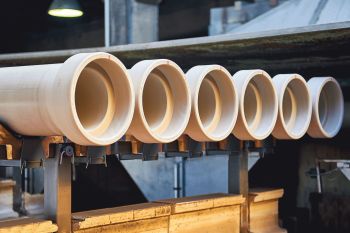CIRCULAR ECONOMY
From the disposable to the recycling economy
Growing resource scarcity and the need for efficient waste reduction make eco-friendly materials and production methods increasingly important. That’s why long-term sustainability should be treated as the normal practice in any industry. Up till now the construction sector has ranged among the world’s largest waste generators.
Fortunately Circular Economy can help to diminish the related negative impact on the environment. One of the most important parameters in this regard are materials that can be sourced locally and recycled easily. Although many materials claim to be circular, there can be huge differences in their actual qualities.
WHAT DOES CIRCULAR ECONOMY MEAN?
The term stands for a wide variety of measurements that can take effect in different stages of a product’s lifecycle. In contrast to the traditional linear economy, this regenerative approach strives to minimize waste, pollution and carbon emission, enhance the longevity of products and enable the reuse of valuable resources.
CIRCULAR ECONOMY IN EUROPE
Europe is working hard to build a more sustainable society, and recently introduced its sustainable growth initiative, the European Green Deal. A major part of this is the newly adopted Circular Economy Action Plan, which sets out measures that include making sustainable products the norm in the EU; ensuring less waste; making circularity work for people, regions and cities; and leading global efforts on circular economy.
CERAMIC-BASED MATERIALS –SOLUTIONS FOR A BETTER TOMORROW
Ceramic-based materials are known for their outstanding durability and high resilience with an average service life of more than a century. The unmatched mineralogical qualities of this material have been confirmed by the Bologna Ceramic Center*, which has completed an important study of the durability of vitrified clay pipes for sewer construction. They conclude that ceramic materials have an excellent score on mechanical parameters such as chemical-physical performance, durability and stability over time. Their smooth, compact and waterproof glass layer provides excellent hardness and perfect resistance to abrasion. The long possible useful life adds to the excellent resource efficiency of ceramic-based materials and make them the perfect solution for a better tomorrow.
*Source: Centro Ceramico Bologna, Studio sulla durabilità dei tubi in gres ceramico per condotte fognarie (2016). Bologna

VITRIFIED CLAY PIPES - RESPONSIBILITY IN PRACTICE
Clay is a natural mineral, available as a virtually unlimited resource. It is the main component of our vitrified clay pipes. As no further chemicals or additives are necessary in the production process, their ecologic footprint can be kept very low. Our pipes are an essential part of municipal infrastructures, transporting wastewater safely from buildings and roads to treatment plants. Vitrified clay can withstand extreme temperatures or chemical attack and is completely recyclable when eventually taken out of service. Currently 30-50% of the raw material used in vitrified clay pipe production comes from recycled clay products.
Sewage systems have to be operated for a long period of time, meaning that low maintenance is one of the most important requirements. Repair and rehabilitation works can be expensive, damaging to the environment and disruptive to residents and traffic. Here the use of vitrified clay pipes provides an ideal solution. It offers decision-makers an economic investment in a reliable, future-compliant sewage system. Vitrified clay pipes present a cost-effective and eco-friendly solution, far superior to products made from other materials. Pipes and fittings made of vitrified clay meet the fundamental requirements of sewage systems. They are
COMMITTED TO IMPROVING THE ECOLOGICAL CYCLE
Thanks to an efficient supply chain we are able to reduce our carbon footprint and improve the ecological cycle in our company and beyond. We focus on ships and trains instead of trucks for transport. We source our clay from sites near to our factories. We recycle our production waste in our own plants. And we purchase additional ceramic waste, in effect serving as a kind of a recycling center. In addition, material in the end-of-life state can be treated right at the work site and used as a foundation for new projects. This means no transport and no CO2 emission.
Furthermore, we have concluded an energy contract with the Flemish government, in which we have committed to implement energy measures with an annual reduction of around 500 tonnes of CO2.
The use of vitrified clay pipes is the first step to sustainable thinking and acting. Vitrified clay is 100% recyclable. Unlike other materials, it also remains eco-friendly in the recycling process. There are no additives or chemicals needed and the quality of the recycled material is exactly the same as the original. Not only do we reintroduce our own recyclable materials into our production cycle, we also include external waste – without any forfeit of quality. Our products are ICMQ-certified, which means that the amount of recycled content in our materials is constantly third-party controlled. Steinzeug-Keramo will continue to optimize its production processes in order to fully meet the circular economy approach.

CHOOSE STEINZEUG-KERAMO
Steinzeug-Keramo has had its products and production processes certified. The Cradle to Cradle Certified® certificate documents our commitment to the environment and is a confirmation of our sustainability-oriented product philosophy. The five main pillars of the cradle-to-cradle certification are: material health, material reutilization, renewable energy and carbon management, water stewardship and social fairness. This shows that our philosophy covers many more themes than just the idea of eco-friendly recycling.



